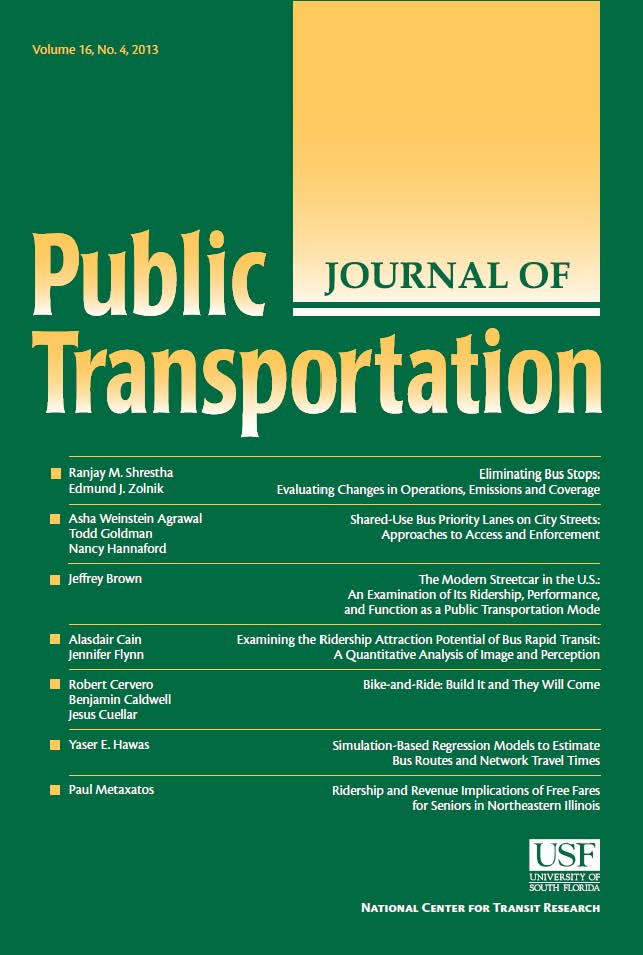基于多源车载传感器数据的交叉口公交司机减速行为建模
IF 2
4区 工程技术
Q3 TRANSPORTATION
引用次数: 0
摘要
了解各种因素对交叉口公共汽车减速行为的影响对公共汽车运行控制、管理和安全具有重要意义。本文利用车载闭路电视(CCTV)、高级驾驶员辅助系统(ADAS)、公交车控制器局域网(CAN)、公交车运行和司机个人资料等数据,建立了一个多元线性回归模型,分析了影响交叉口公交车司机减速(安全驾驶状态的一种代表)的因素。我们开发了一个全面的模型数据提取框架和相应的方法来有效地估计/计算公交车减速率(因变量)及其影响因素(自变量)。本文利用中国典型公交线路的数据,探讨了影响交叉口公交减速行为的因素。结果突出了显著因素,包括驾驶员特征(年龄)、路线和交叉口接近驾驶状态(行程延迟、转弯时间、行驶方向和接近速度)、交叉口特征(类型、车道数、斑马线、分隔线、公交车道、右转弯车道、停车位置)和交通状况(周围车辆)。一般来说,年龄较小(反应时间较短)和对复杂情况(从周围车辆和行人或无信号路口)有心理预期的司机往往减速更平稳。这些机构可以通过在时间表上允许足够的周转期,建议路口接近速度,以及提供定制的ADAS系统警报(而不是淹没所有警报)来提高公共汽车的安全驾驶行为。此外,考虑到公共汽车基础设施(如专用车道和停车点)对十字路口安全驾驶行为的软贡献,应该对其规划进行适当的评估。本文章由计算机程序翻译,如有差异,请以英文原文为准。
Bus driver deceleration behavior modeling at intersections using multi-source on-board sensor data
Understanding the impact of various factors on bus deceleration behavior at intersections has important implications for bus operations control, management, and safety. This paper develops a multiple linear regression model to analyze the factors influencing bus driver deceleration (a proxy of safe driving state) at intersections using data from multiple sources, including the on-board closed-circuit television (CCTV), the advanced driver assistance system (ADAS), the bus controller area network (CAN), the bus operation, and the driver profile data. We develop a comprehensive model data extraction framework and corresponding methods to effectively estimate/calculate the bus deceleration rate (dependent variable) and its influencing factors (independent variables). We explored the factors impact on bus deceleration behavior at intersections using data from a typical bus route in China. The results highlight significant factors, including driver characteristics (age), en-route and intersection approaching driving states (trip delay, turnaround time, driving direction, and approaching speed), intersection characteristics (types, the number of lanes, zebra crossing, divider, bus lanes, right turn lanes, the stop location) and traffic conditions (surrounding vehicles). Generally, drivers with younger ages (having short reaction times) and driving with psychological anticipation of complex situations (from surrounding vehicles and pedestrians or unsignalized intersections) tend to decelerate more smoothly. The agencies may enhance safe bus driving behavior by allowing enough turnaround time in timetabling, recommending intersection approaching speed, and providing tailored ADAS system alarms (rather than flooding all alerts). Also, the planning of bus infrastructures (e.g., dedicated lanes and stop locations) should be properly evaluated considering their soft contribution to safe driving behaviors at intersections.
求助全文
通过发布文献求助,成功后即可免费获取论文全文。
去求助
来源期刊

Journal of Public Transportation
TRANSPORTATION-
CiteScore
6.40
自引率
0.00%
发文量
29
审稿时长
26 days
期刊介绍:
The Journal of Public Transportation, affiliated with the Center for Urban Transportation Research, is an international peer-reviewed open access journal focused on various forms of public transportation. It publishes original research from diverse academic disciplines, including engineering, economics, planning, and policy, emphasizing innovative solutions to transportation challenges. Content covers mobility services available to the general public, such as line-based services and shared fleets, offering insights beneficial to passengers, agencies, service providers, and communities.
 求助内容:
求助内容: 应助结果提醒方式:
应助结果提醒方式:


